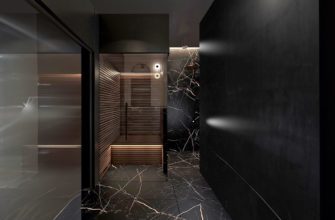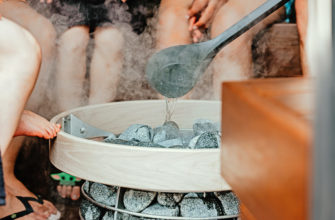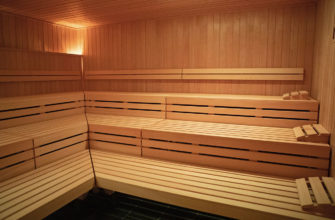Thermowood is becoming more and more popular in Poland every year. It is used for saunas, durable floors, terraces and pergolas, balconies, as well as for the interior and exterior finishes of houses. Thermowood is also used in more demanding cases, such as decks, fences, outdoor furniture, pool lounges and even bathrooms.
Thermwood is highly resistant to the elements and retains its excellent appearance for a long time. What is its secret? What is thermo wood and how does it differ from standard wood? Let’s find out.
Thermowood properties
It is obvious that wood is an ecological material, natural, beautifully textured and completely safe for human health. However, without additional treatment, wood is unable to resist adverse external factors such as high humidity, biological microorganisms and insects.
The modern method of treating raw wood with thermo-modification has resulted in a new quality of finishing material that has found a wide market demand. Thermo wood is wood that has been subjected to additional thermal treatment at high temperatures of 180 to 240 degrees without the use of synthetic additives and chemicals, thanks to which it has gained a number of extremely important and useful properties that conventional construction wood cannot boast.

Here are the main advantages of Thermowood:
- Dimensional stability under the influence of adverse environmental conditions – temperature and humidity (in contrast to untreated wood, it improves 10-15 times, the risk of swelling in a humid environment is reduced by up to 90%).
- Hygroscopicity, or in other words, reduced moisture absorption. The moisture content of wood is reduced to 4-8 percent, which is much lower compared to industrial drying of lumber in special chambers. Thermally treated wood absorbs 5 times less liquid from the atmosphere compared to untreated wood. With prolonged exposure to humid conditions and directly in water, the maximum moisture content of the raw material does not exceed 9-10 percent, and natural drying takes place very quickly.
- Long life, resistance to biological damage. Treatment of wood at high temperatures causes the decomposition of polysaccharides, which at low humidity of the raw material minimizes the risk of damage by microorganisms, mold and fungi.
- High thermal conductivity. Thermowood is an ideal material for sauna and banya rooms, as its thermal insulation properties are up to 30 percent higher than natural wood. Due to its high density, thermo wood is better at retaining heat in winter and coolness in summer.
- The high density of the wood makes it repel water without additional treatment, the lumber does not absorb moisture from the air. After heat treatment, the lumber is mechanically stable.
- Ecological purity, absolute safety for the human body and the environment.
- High fire safety. The hardness and density of heat-treated wood makes it burn slower than untreated wood.
- Aesthetic appearance of thermo wood. After thermal processing, the decorative properties of lumber are clearly improved – it reveals a striking wood grain and a noble dark shade. Thermal processing gives even inexpensive wood species the appearance of high-value species and serves as a means of naturally aging the wood.
- Ease of installation. Since thermal board is three times lighter than untreated wood, it is easier to install. However, this type of construction requires following a number of rules during installation (which is one of its drawbacks).
Disadvantages of thermwood
Thermowood burns in the sun due to UV exposure, so it requires the use of a special oil for wood preservation.
If you plan to use thermo wood for exterior work (facade work, installation of decking boards and making garden furniture), be sure to impregnate it with teak oil, varnish or paint. Otherwise, that is, without a protective coating, the boards under direct sunlight will gradually discolor, taking on an ugly gray color due to chemical changes under ultraviolet radiation. Most coatings, with the exception of thick varnishes, protect against fading without obscuring the natural texture of the wood and allowing it to breathe. However, there are a number of environmentally friendly impregnations that do not contain harmful chemicals.
High brittleness of wood. Thermo wood should be sawed with a special tool with fine teeth at high speed and low feed of the workpiece. If the conditions and requirements for sawing are not met, the workpiece will break.
Fastening thermo wood with nails or self-tapping screws can also damage it, so special concealed clamps should be used.
Treatment and painting of thermo wood
In order to increase UV stability, treatment with a special oil should be carried out. As a result, UV resistance is increased, and exposure to light will no longer be a problem. This method of treatment eliminates the use of any chemicals.
Thermo wood can be painted with paint, varnish or colored oil.
When it comes to painting, it is best to use breathable oil paints to paint thermo wood. Acrylic and alkyd paints will hide the texture of the wood, and over time they will crack and begin to peel.
An excellent solution is to paint Thermo wood with translucent varnish. It allows you to achieve a tinted and glossy finish. The varnish is water-based or oil-based.
Here we return to oiling wood with oils. If teak oil impregnation is not suitable for you, and you want to slightly change the color of the wood, you can buy oil with a coloring pigment. The oil will make the dried wood more flexible, less brittle and protect it from dirt and water.
Painting and oiling thermowood is best done in summer, when it is warm and dry outside. The coating will then adhere well, soak in and harden.
The consumption of impregnant or paint is less for the interior than for the exterior.
Beforehand, clean the surface of the boards from dust. Then apply the first coat and let the paint dry for about a day. Intermediate sanding can then be done, and after the dust is removed, apply a second coat of waterproofing. Special attention should also be paid to the ends of the boards, which are often additionally waxed to prevent them from cracking over time.
Installation
The installation of thermowood should not be done using the same methods as regular boards. When nailing or screwing thermo wood, the hole in the plank should be carefully drilled beforehand. If this is not done, the plank will crack.
The best way to fasten thermo wood is with internal hidden fasteners made of stainless steel.
Thermowood has a unique combination of performance characteristics: thermowood is durable, environmentally friendly, reliable and beautiful. We hope that after reading this article you have no doubt that thermowood is one of the most attractive decorative materials for your sauna.








